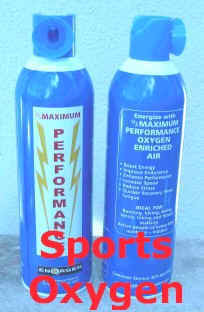|
ABOUT
SPORTS OXYGEN
 Oxygen comes in
at least three classifications. The
most common classification is medical grade oxygen, which requires a
doctors prescription. Medical
grade oxygen is usually 95 to 100 percent oxygen.
The second most used classification is Industrial grade oxygen used
in welding, jewelry making and airlines, and is probably about 95% oxygen.
The third most used classification is called recreational oxygen
and can range form 20% to 95% oxygen while the balance is nitrogen.
Normal atmospheric air at sea level is 21 percent oxygen, 78
percent nitrogen, and 1 percent miscellaneous gasses. Oxygen comes in
at least three classifications. The
most common classification is medical grade oxygen, which requires a
doctors prescription. Medical
grade oxygen is usually 95 to 100 percent oxygen.
The second most used classification is Industrial grade oxygen used
in welding, jewelry making and airlines, and is probably about 95% oxygen.
The third most used classification is called recreational oxygen
and can range form 20% to 95% oxygen while the balance is nitrogen.
Normal atmospheric air at sea level is 21 percent oxygen, 78
percent nitrogen, and 1 percent miscellaneous gasses.
Sports oxygen,
SportsOxygen.com, is recreational oxygen, usually 85 percent to 95 percent
oxygen, and is used to increase stamina and endurance during sports
activities. Studies show that
oxygen is responsible for up to 90 percent of your body’s energy
production. Used before
competing it will provide one with a longer period before fatigue sets in.
Used during competing, it will almost immediately restore ones
energy. Used after competing,
it will eliminate the fatigue is about 2 or 3 minutes.
One time we were
serving oxygen from our oxygen bar at a motor cross race that was 6 laps
starting in Lake Elsinore going out into the country side and back through
Lake Elsinore. Normally
riders become fatigued after 3 laps and just hang on to finish the race.
Usually after three laps the race is a parade with little passing
of riders.
After one race
on Saturday a Mr. Snodgrass came by our oxygen bar to get oxygen so he
would have the energy to ride back to his camp.
He was totally exhausted and a ball of sweat.
After his oxygen session, he felt much better. He said he had taken 3rd place in his race but his
big race was Sunday.
On Sunday
morning Mr. Snodgrass came back before his race and brought 6 friends with
him to get oxygen before racing. Mr.
Snodgrass was competing against tougher competition and took first place
in his race. He had hardly
broken out in a sweat after the race.
His buddy was in
a different class and led the race from the start until the third lap when
he fell off his bike and down a 20 ft embankment.
It took a while to climb back up to his bike and start racing
again. 4 riders had passed
him during this time and he took off after them, passing all 4 riders and
taking 1st place. These
4 riders were too exhausted to ride aggressively and were easy to pass. They did not have oxygen before the race.
A third buddy of
Mr. Snodgrass was competing in his first motor cross race, against other
beginners, and he took 1st place.
The other 3 friends of Mr. Snodgrass all reported finishing much
better than they had ever finished before and credited the oxygen bar for
their success.
Sports oxygen,
or oxygen in a can, is now available from several online sources.
It is so new, that most retailers are not aware of it and do not
carry it in their stores yet. There is an effort to develop a marketing network to promote
oxygen.
Sports oxygen
can be beneficial in almost any sport.
It not only increases stamina and endurance, it also improves
memory and alertness levels so one can benefit from making better
decisions while competing, or taking an exam.
Sports oxygen is
also used for high altitude sickness.
headaches, hangovers, stress, jet lag, cramps, and minor aches and
pains can all benefit from oxygen. Currently
the largest market for oxygen in a can is Colorado because of its high
altitude at ski resorts.
|